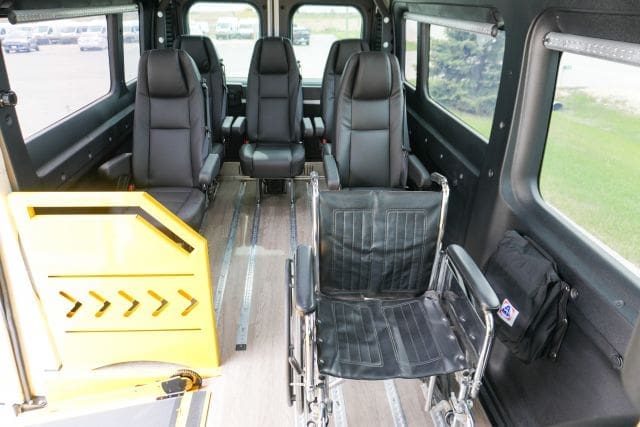If your organization is considering starting a mobile medical clinic in the U.S., you may wonder how it’s different from a regular clinic. Traditional clinics are plagued by limited accessibility, long wait times, transportation barriers, and high operational costs.
Mobile medical clinics are a game-changer. They do away with barriers that traditional clinics face while welcoming accessible healthcare on your patient’s terms. At AVAN Mobility, we’re not just experts in manufacturing mobile medical clinics, we’re pioneers in transforming how organizations provide medical care.
In this article, we compare mobile medical clinics vs. traditional clinics. By the end of reading, you’ll have a clearer picture of the differences and similarities between these two options.
What are mobile medical clinics?

Mobile medical clinics are like a doctor’s office on wheels. They’re special vehicles designed to bring healthcare to people who have a hard time going to a regular doctor’s office or hospital. These clinics are important because they make it easier for everyone to get the medical care they need.
The nicest thing about mobile medical clinics is their flexibility. They travel to places where people don’t have easy access to regular medical care. This includes rural areas, neighborhoods without nearby hospitals, or communities being impacted by emergencies like hurricanes or floods. It’s like bringing the doctor’s office to your patient’s doorstep.
Inside a mobile medical clinic, your team can include doctors, nurses, and other healthcare experts. They have all the medical tools needed to help their patients. Here are some things they can do:
Basic check-ups: Staff inside mobile medical clinics can do simple health checks. This includes checking blood pressure, giving shots, or testing for diabetes.
Special care: Some mobile clinics offer specialized services, such as dental check-ups, eye exams, and mental health help.
Emergencies: When disasters or accidents happen these clinics can act fast. Mobile medical clinics make it convenient to provide care when regular hospitals are far away or super busy.
Who gets help?
Mobile medical clinics help lots of people, like:
Rural folks: If people live far from a hospital, these clinics can be a lifesaver. Nearly 23% of Americans in rural regions say access to good healthcare is an issue.
People with mobility challenges: Going to a traditional clinic is hard for people with mobility challenges. Mobile medical clinics are versatile and can directly visit these people.
People in crisis: They help folks who are homeless, refugees, or facing tough times with their health.
How they work
Mobile medical clinics are like medical Swiss Army knives. They’re packed with equipment and have an area where patients can be examined. The medical team travels with the clinic and takes care of patients in their communities.
These clinics typically follow a schedule and make stops at predetermined locations. Mobile medical clinics reach out to the community to inform them about upcoming visits.
When patients step into the clinic, professionals are there to help them with any health concerns they might have. These clinics are often customized to meet the specific needs of the communities they serve. They’re designed with efficiency in mind to provide the right care for the people in that area.
Click the button below to dive into our five-part series on mobile clinics.
What are traditional clinics?
If you’ve ever been to a medical clinic or hospital before, you probably have a rough idea of what traditional clinics are. Traditional clinics are the brick-and-mortar kind of healthcare center where you can go to see a doctor or nurse for medical care. Unlike mobile medical clinics that travel to you, traditional clinics are stationary, and you need to go to their location.
Traditional clinics offer a wide range of medical services. They’re staffed with skilled healthcare professionals. Here’s what you can expect at a traditional clinic:
Regular check-ups: You can visit a traditional clinic for routine check-ups to monitor your overall health. During the visit, the doctor will check blood pressure, talk about health worries, and give vaccines, if necessary.
Specialized care: Traditional clinics have specialists like dermatologists, cardiologists, and pediatricians. If you have a specific health issue, they can provide expert care tailored to your needs.
Emergency care: Many traditional clinics have an emergency room (ER) where they treat serious injuries and medical emergencies. They’re equipped to handle critical situations.
Pharmacy services: Some traditional clinics have pharmacies on-site. It makes it easy to get prescribed medications conveniently.
Now, let’s dive deeper into who benefits from traditional clinics and how they operate.
Who gets help
Traditional clinics serve a broad spectrum of people, including:
Families: Families often visit traditional clinics for routine check-ups and vaccinations for children. They’re a go-to for keeping everyone in the family healthy.
Individuals with chronic conditions: People with ongoing health conditions like diabetes, heart disease, or asthma rely on traditional clinics for regular check-ups and managing their conditions.
Emergency cases: In emergencies, like accidents or sudden illnesses, anyone can seek immediate care at the clinic’s emergency room.
How they work
With a traditional clinic, you call the clinic or use their online system to book an appointment. This helps manage the number of patients they can see at a given time. When you arrive at the clinic, you check in at the front desk. They’ll ask for your information and appointment details.
You’ll wait in a designated area until it’s your turn to see the healthcare provider. Many clinics have comfortable waiting rooms with magazines or TVs to pass the time. When it’s your turn, a nurse or doctor will take you to an examination room. They’ll ask about your symptoms, do necessary tests, and discuss your health concerns.
The healthcare provider will provide treatment, prescribe medication, or recommend further tests depending on your condition. They may also schedule a follow-up appointment if needed.
Similarities and differences between mobile medical clinics and traditional clinics
Mobile medical clinics and traditional clinics have similarities and differences that are worth looking into. Let’s start by exploring the similarities between them.
Similarities
Healthcare services: Both types of clinics in the U.S. are here to provide healthcare services. They help diagnose, treat, and prevent illnesses to keep people healthy.
Medical professionals: In both types of clinics, you’ll find doctors, nurses, and other healthcare experts. They work hard to care for patients and offer their medical knowledge.
Equipment and medicines: These clinics have the tools and medicines needed to diagnose and treat various medical problems. They’re ready with supplies to help patients.
Differences
Accessibility: Mobile medical clinics go to different places and make reaching areas with fewer medical services easier. These clinics are designed to be accessible to everyone, including people with disabilities.
Traditional medical clinics are more challenging to reach because they’re only in one place. Getting to a certain clinic will require some method of transportation. This makes it tough for people without reliable transportation or for those who have mobility issues.
Who they serve: Mobile medical clinics actively reach out to schools, workplaces, housing and homeless societies, and remote communities, bringing healthcare right to the people.
Traditional clinics serve people who come directly to them. They don’t reach out to specific places like mobile medical clinics do.
Adaptability: They’re flexible and can adapt to different situations and places. Mobile medical clinics offer various medical services, from check-ups to special care. They can be customized depending on what services your organization wants to offer.
Traditional clinics often offer a set menu of services, and it’s not easy for them to add or change services quickly. You might have to go to a different clinic or facility if you need something specific.
9 challenges of traditional clinics vs. mobile medical clinics
Traditional clinics face various challenges. Let’s take a closer look.
1. Limited accessibility: Traditional clinics are fixed in one place, which can be tough for people in far-off or underserved areas to get to. Mobile medical clinics solve this problem by bringing healthcare to these communities.
2. Long wait times: Traditional clinics can have really long waits for appointments, which can delay getting the care you need. Mobile medical clinics provide quicker, on-the-spot services.
3. Transportation challenges: If patients don’t have a reliable way to get to a regular clinic, it’s hard to access healthcare. Mobile medical clinics solve this by coming directly to patients.
4. High costs: Running a fixed clinic involves many expenses, making healthcare more expensive for patients. Mobile clinics often have lower costs.
5. Limited outreach: Traditional clinics wait for patients to come to them, which makes it hard to reach people in need. Mobile clinics actively reach out to communities, making sure everyone can get healthcare.
6. Limited hours: Regular clinics often have set hours that don’t fit with patients’ schedules. Mobile medical clinics offer more flexibility with different times and locations.
7. Preventive care: People in regular clinics often focus more on treatment than on preventing health issues. Mobile medical clinics stress the importance of preventive services for overall wellness.
8. Privacy and stigma: Some patients feel uncomfortable going to a regular clinic for specific conditions. Mobile clinics offer a more private and discreet setting for care.
9. Community involvement: Regular clinics sometimes struggle to connect with the communities they serve. Mobile medical clinics build stronger community ties by being right where the people are instead of patients coming to them.
Your next steps with AVAN Mobility
You came across this article while researching mobile medical clinics.
Now, you have a clearer understanding of how mobile medical clinics set themselves apart from regular clinics.
At AVAN Mobility, our team puts a lot of effort into making mobile medical clinics. Your organization can customize them depending on what people you serve. To get a better idea of what type of mobile medical clinic vehicle will work best for your purposes, check out these two articles:
- Mobile Medical Van vs. Mobile Medical Bus: What Are the Differences?
- Mobile Medical Vans vs. Mobile Medical Trailers
If you have any other questions, don’t hesitate to click the button below to talk to a mobility expert today.





